Rocco Pugliese was a young
militant of the Communist Party of Italy (see his portrait
and photo), from the Italian
region of Calabria. In 1930 he was assassinated by the fascist
jailers in the penitentiary
of Santo Stefano island, in
Pontine archipelago, where he had been deported as a result of
the fascist "special court" sentence in 1928.
Rocco was born on January 27th 1903 in Palmi, in the province
of Reggio Calabria, from Giuseppe Pugliese and Maria Polimeni,
and since his earliest age he was a Socialist Party militant,
being in 1921 amongst the founders
of the Palmi cell of Communist Party
of Italy, recently founded,
becoming then its secretary at the age of eighteen.
Rocco had a decisive revolutionary political training during his
the required military service, performed in Turin, a working-class
city, where the revolutionary movement was very strong and active.
The military service period was a proper school for executive
cadres, and the young man who came back to Palmi after being discharged
was a mature and conscious Communist executive (Pugliese L.).
In 1925, the year of the facts which led him to be a victim of
the fascist murderers, Rocco was a student of accounting. In città
Rocco era conosciuto anche con i soprannomi di .In the town Rocco
was also known by the nicknames of "Chiacchiarella"
("chatty") and "Mussuni" ("big
face"). (Bongiorno)
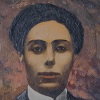
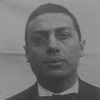
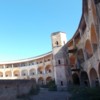
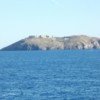
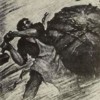

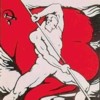
The premises
for Palmi events
Palmi, a town of southern Italy, in the
region Calabria, at that time had about 15,000 inhabitants (today
counts 19,000), it was a red stronghold, center of an intense
socialist and later communist political activity in a territory
with large estates (mainly citrus and olive plantations) with
a heavy exploitation of day labourers' manpower (Pugliese L.). The Palmi Socialist Party cell was established
soon after the devastating earthquake of Messina and Reggio Calabria
of December 28th 1908, which caused victims and
damages in the town. The Socialist Party Youth Club had 80 members,
and 78 of them voted in 1921 for the communist motion. (Bongiorno)
One of the most significant battle of the revolutionary movement
in Palmi was the winning one against the unreasonable rent imposed
by Palmi municipality to the people who dwelled the hovels built
for the homeless after the earthquake, and left in use for twenty
years, until 1928. (Pugliese
L.)
On June 27th, 1924 to protest the assassination
of the Socialist member of parliament Giacomo
Matteotti, the General Confederation of Labor proclaimed a
symbolic strike of ten minutes, which the Communist Party invited
to extend throughout the day, as happened in Palmi (Bongiorno), where it remained memorable
the march, when five thousand anti-fascists paraded reaching then
the town cemetary to lay wreaths and flowers (Spezzano, 1975).
The strong anti-fascist presence in Palmi made it the target of
violent assaults by fascist gangs, particularly numerous, since
Palmi fighters fasces (the fascist party cell) was one of the
first to be founded in the province of Reggio Calabria.
On November 4th, 1920, the second anniversary
of the victory in the World War I, a group of fascists, which
included two mafiosi, hired by the fascists to oppose the left,
one of whom was the convict Santo Scidone, attacked the Chamber
of Labor of Palmi, devastating it. (Bongiorno)
In the elections of April 6th, 1924, the Communists presented
one of their candidates, the lawyer Diomede Marvasi, in the college
of Palmi. Two evenings before the elections the Communists were
putting up their electoral posters when they were harassed by
a team of mafia headed by Scidone, and Rocco Pugliese came up
to them with a gun in his hand, started talking to the attackers
and convinced them to desist from provocation. (Bongiorno)
Marvasi came very close to being elected: he obtained 929 votes,
missing the quorum for a short delay, in return Fausto Gullo was
elected. (Bongiorno) The party cell counted three
hundred members, and one hundred and eighty were the members of
the juvenile circle, being mainly peasants and labourers, besides
professionals and students.
The strength of the anti-fascist movement in Palmi manifested
itself in a continuous contrast to the expansion of the emerging
regime, as when the fascist top dog Michele Bianchi was twice
prevented from giving a speech in Palmi, causing a short circuit
on the power grid and pushing him first to to stop outside the
city and then to to give up the event for safety reasons. (Pugliese L.,
Bongiorno)
In 1923 the leader of the fascist squads, Roberto Farinacci, came
to Palmi to defend in the Court of Assizes the fascists accused
for a clash that took place in Maropati, a town 35 km from Palmi,
where the fascists had murdered the mayor's brother while a rich
financier of the squads had been killed (Bongiorno).
In view of the Labor Day of May 1st, 1925, on the night between 29th
and 30th April, to prevent the celebrations,
ten anti-fascist leaders were arrested on pretexts, among them
Giuseppe Florio, and the brothers Giuseppe
and Antonino Bongiorno. These
latter shouted conventional yells in the street while the police
arrested them, and in this way Rocco Pugliese and Giuseppe Marafioti,
who lived near them, managed to slip away. (Bongiorno)
The reaction was a general strike, held on 2nd
and 3rd May, with street demonstrations
that had a so big attendance, that the authorities did not dare
to counter them. The fascists planned to disrupt the protest by
attacking the communist section, but the Palmese communists, led
by Rocco Pugliese, prevented them by devastating the local headquarters
of the fascist party, destroying the insulting cartels against
the strikers and slapping the fascists and forcing them to keep
off the town. (Bongiorno,
Pugliese L.)
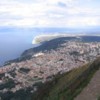
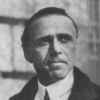
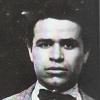
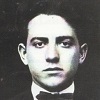
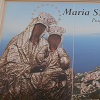
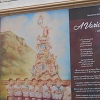
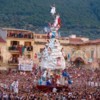
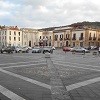
On 20th
July in Palmi the feast of Sant'Elia Profeta was celebrated, with
traditional jaunts and songs and dances on the mountain of the
same name. The young communists of the city gathered to sing socialist
anthems, but were the target of the aggression of the fascist
Francesco Saffioti, who fired a shot at the group, without hitting
anyone. Chased through the woods, Saffioti managed to escape,
but the same night the police arrested thirteen communists for
attempted murder, in the person of Saffioti himself. After thirteen
days in prison, the arrested were released, without even being
questioned, thanks to the numerous testimonies that cleared them.
(Bongiorno)
On August 15th of the same year a squadron of
fascists from neighbouring villages camped in the night at the
gates of the town, near the Agricultural Institute, to attack
and set fire to the shacks of the leaders of the left parties
of Palmi, but they were put on the run by a hundred men, led by
Rocco and Giuseppe Pugliese and Antonino Bongiorno, who broke
into the fascist camp. Rocco ordered the leader of the fascists
to leave Palmi immediately, otherwise they would have been attacked,
and the fascists accomplished. (Bongiorno)
The ground which caused the events of August 30th,
1925 were the repeated humiliations suffered by the fascists in
Palmi, all the more harsh since they endorsed an ideology based
on arrogance and overman ideology, while in many other parts of
Italy Fascist gangs dominated uncontested.
The events
of the Varia
On August 27th, 1925 the religious celebrations
of the Virgin of the Letter
began in the town, with the traditional festivity of the Varia,
a great votive chariot symbolizing the
Assumption, dragged in procession by 200-300 faithfuls (the "mbuttaturi")
in the streets of the town, with the accompaniment of the band
(since 2013 the feast, together with three other similar Italian
celebrations, is inscribed in UNESCO Intangible Cultural Heritage
of Humanity, see link).
In 1925 the fascists imposed that during the festivity the Frigento
band, one out of two involved in the feast, played their anthem
"Giovinezza" (meaning "youth"), and
the (fascist) president of the celebration commitee, supported
this abuse.
The fascists wanted then to impose their anthem was played also
during the procession, instead of the traditional march composed
by Rosario Jonata, and the Palmi people rebelled to this overbearingness,
requiring the restitution of the contributions payed and boycotting
the transport of the Varia, considering also that the bearers
by tradition belonged to the five corporations: carters, sailors,
butchers, artisans and farmers, who mainly were Communist and
Socialist.
The leftist militants, first of all Rocco Pugliese, engaged in
a capillary work of persuasion to push the porters to boycott
the transport. (Bongiorno)
Actually just five
sailors and five carters offered themselves for the transport
of the chariot, and the procession, turned into a fascist political
parade, was boycotted even by the priests: indeed just one of
them took part in the procession. The fascists were forced to
improvise bearers to complete the procession. (Bongiorno)
The fascist gangs' provocations went on, even with insults and
threats to left-wing militants in the streets of Palmi, and the
tension reached its maximum at midnight of August 30th,
while the town population was gathering in the main square, piazza
Vittorio Emanuele, currently piazza
1° maggio, to watch the fireworks. Antonino Bongiorno,
Rocco Pugliese and Giuseppe Marafioti also were going to see the
launch of balloons in praise of the Soviet revolution, which they
had made prepare. (Bongiorno)
The fascists burst into the De Rosa café, which lied besides
the fascist party headquarters, but whose tables were as usual
crowded by Communists and Socialists, insulting them and starting
to sing once more "Giovinezza". Rocco Pugliese
summoned to stop provocation, beginning to sing the Communist
anthem “Bandiera Rossa" (Red Flag), but he was
assaulted with a stick by the fascist Rocco Gerocarni and reacted
throwing him a chair. During the brawl some gunshots were fired,
and two fascists were wounded: Rocco Gerocarni, that died the
following day, and Rosario Privitera, besides to two passers-by
(see the news on the Communist
Party's newspaper "l'Unità"
of September 2nd 1925 and the fictional
version of the official Press Agency Stefani, drawn by the
Turin newspaper "La Stampa" of September 1st,
1925).
According to the author Leonida Repaci (see below) who was a witness
of the events, the actual target of the shots was he himself,
who was scratched by two bullets, while the third one killed Gerocarni.
The shots were fired from above to below from the terrace of Sambiase
family, facing the café, by the same fascists, who by mistake
shot their companion Gerocarni. The motive of the ambush should
be included in the framework of the sudden rise of violence by
the hard-liner wing of fascism, leaded by the fascist beaters'
boss Farinacci, in order to break the deadlock in which Mussolini
had fallen after Matteotti's murder and the consequent reactions
by the antifascists. The target of Palmi assault was anyway a
town with steady antifascist principles, who was therefore punished
for its refuse to submit to fascist hooligan's violence.
The reaction of the recent fascist regimen was very tough: a real
manhunt began and the police commissioner Francesco Cavalieri
arrested many antifascists of the region, accusing them of organizing
a subversive conspiracy; the same Cavalieri later admitted, during
the trial, that the arrests were due to political reasons instead
to the homicide (see the news on "l'Unità"
of September 8th, 1925).
Farinacci sent a telegram spurring them to the revenge ("I
can assure you that fascist blood shedding these days will be
avenged in due time") (Bongiorno) and
the September 15th the fascist gangs devastated
the circle "Unione e Progresso" and the house
of the communist laborer Managò, who was later arrested
by the police. The fascists also assaulted the house of Leonida
Repaci's brother where they stole objects and money, and tried
to burst into the Palmi jail, in order to lynch the antifascists
arrested for the Varia events. According to Antonino Bongiorno
and Leonida Repaci, a prisoner linked to the mafia, a certain
Giovanni Campanella, allegedly foiled the fascist assault, perhaps
out of a desire for personal redemption, dissuading the fascists,
also thanks to large quantities of weapons hidden in the prison.
(Bongiorno)
The journalist Giuseppe Dato, correspondent of the newspaper "Gazzetta
di Messina e delle Calabrie", even being a fascist too,
was assaulted and thrown in a basin full of water, because he
had criticized in a correspondence the fascist gangs' violences.
In the following days the fascists impeached, as a matter of fact,
the access to everybody they didn't agree, including the prisoners'
lawyers (see "l'Unità"
of September 15th 1925).
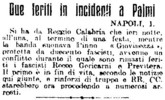

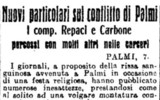
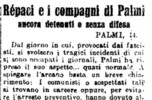
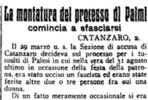
The "trial"
The dead of Gerocarni
was attributed to the communists as a preconception and preliminary
investigation was conducted in an extremely partial way: many
witnesses who had given depositions for the prosecution, retracted,
reporting they had been threatened by the fascists. In the same
year, in October, two of the witnesses killed themselves, and
one of them left a message explaining his suicide was due to the
remorse for wrongly accusing Leonida Repaci, Giuseppe Pugliese
and Giuseppe Marazzita, but the court did not consider this.
Some of the accusations brought against the anti-fascists were
grotesque: a witness, a certain Giuseppe Vizzari, claimed "to
have recognized the brothers Bongiorno, Carbone and Marazzita
by the flames of their guns". Even the victim, Rocco
Gerocarni, was among the witnesses: despite being dying he would
have indicated the names of five shooters, all Communists, including
Rocco Pugliese. It later turned out that he would only nod his
head when one of them was named, perhaps aided by someone holding
his head with his hand. (Bongiorno)
On December 5th, 1925 Barone Ferrara, the Attorney
general by the Court of Appeal of Catanzaro, asked to commit thirty-one
persons to trial for complicity in premeditated homicide and missed
premeditated homicide. The prosecution section of the Court of
Appeal of Catanzaro on March 29th, 1926 committed 15 persons to
trial by the Court of Assizes of Palmi, while the others were
acquitted with the formula of "not guilty" or on the
grounds of insufficient evidence, like in the case of Leonida
Repaci (see "l'Unità"
of April 3rd, 1926).
The trial began on October 26th, 1926 at 9:30pm by the Court
of Assizes of Nicastro, where it was remitted for legitimate suspicion.
With an abuse that anticipated the future management of justice
by the part of the fascist regimen, three out of four defence
attorneys appointed by the communist defendants, Francesco Lo
Sardo, Fausto Gullo and Ezio Riboldi, all Members of the Parliament,
were arrested and sent to the confinement, while Nicola Zupo alone
remained in the defense (Bongiorno);
on November 30th, 1926 the trial was then remitted
since the Attorney general asked to commit four witnesses to trial
because they retracted their accusatory depositions. In the same
year 1926, following the attack of the fifteen-years-old Anteo
Zamboni, who tried to kill Mussolini, with the emergency laws
of November 26th 1926 the special
court for the defence of the State was established. The name
of "court" was absolutely unjustified, inasmuch as it
was not constituted by judges, but rather by militants of the
fascist party, and in particular by consuls of the MVSN (National
Security Voluntary Militia).
On March 12th 1928 the Court of Cassation declared
with a sentence that the process had to be assigned to the special
court, where the November 27th
of the same year the
trial began. The fifteen antifascist defendants, who had spent
more than three years in preventive imprisonment, were charged
of "homicide, attempted murder, actions aimed to stir
a civil war up, insurrection against the State".
Between the defendants there was Rocco Pugliese, who had before
the court a not at all submissive behaviour, coherently with his
intransigence in the antifascist struggle. Public Prosecutor Isgrò
defined the defendants as "the group of communists who,
led by Rocco Pugliese, in the square of Palmi, on the evening
of August 30, shot" (Bongiorno)
and asked for Rocco Pugliese for a life imprisonment, for other
eight defendants the term of imprisonment proposed was of 30 years,
while the "lighter" sentence asked was of 12 years,
and for just one defendant the acquittal on the grounds of insufficient
evidence was asked. Death penalty had been abolished in Italy
in 1889 (de facto since 1877) and was restored by the fascist
regime in 1930.
On December 5th, 1928, at 8:30pm, just eight
days after the beginning of the trial, the court (President Antonino Tringali Casanuova, rapporteur
Presti), issued Sentence No 145, that inflicted very tough convictions:
the heaviest, of 24 years and 7 months, was received just by Rocco
Pugliese, while Natale Borgese and Vincenzo Pugliese were sentenced
to 10 years and 8 months, Giuseppe Florio and Gregorio Grasso
to 10 years and 7 months, Giuseppe and Antonino Bongiorno to 8
years and 7 months. This latter was tried again by the special
court in 1935, for organization and participation to the Communist
Party, and was sentenced to 12 years more.
The sentence of Rocco was the hardest issued by the special court
up to that moment, except for those against Gino Lucetti and Tito
Zaniboni, who had tried to kill the duce. (Bongiorno)
The others six antifascists were acquitted, between them Francesco
Carbone, Antonio Sambiase, Giuseppe Pugliese, Pasquale Carella
and Giuseppe de Salvo, besides the Socialist lawyer Giuseppe Marazzita,
which years after was elected in the Senate of the Republic, which
anyway was repeatedy imprisoned in the remaining years of the
fascist dictature.
It must also remember that Fortunato, Rocco's elder brother, born
on May 7th, 1891, cabman by trade, married
with eight children, was arrested on November 30th,
1926 for demonstrating solidarity with Rocco, and was assigned
to confinement in Lampedusa and then to Ustica island. Despite
the death of a daughter and although he was suffering of exuding
trachoma that made him nearly blind, he was kept in detention
and released only in March 1929.
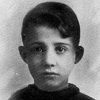
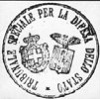
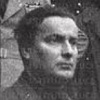
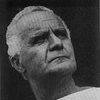
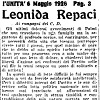
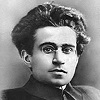
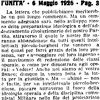
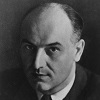
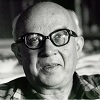
The Repaci
affair
Another antifascist
of Palmi involved in the events of the Varia was Leonida
Rèpaci (1898-1985), writer and later on also painter,
who conceived the Viareggio Literary Prize and was a lawyer too.
According to Francesco Spezzano, senator of the Communist Party
in the post-war period, was the real target, with Rocco Pugliese,
of the punitive expedition of the fascist gang.
Repaci was emprisoned but, as previously mentioned, was then acquitted
during the preliminary investigation and wasn't submitted to the
special Court. His acquittal, like that of other defendant, was
attributed to interventions of men of position, in the case of
Repaci to that of Arnaldo Mussolini, brother of the "duce",
besides the counsel for the defence constituted by big shots of
the regimen. In any case Repaci benefitted of numerous witnessings
of personages well agreed to the fascist regimen. His elder brother
Gaetano was moreover Mussolini's family physician.
While Rèpaci was in jail wrote "In fondo al pozzo"
("In the bottom of the well"), a novel with many autobiographic
references, even to the Varia events of 1925.
Anyway Repaci, after some more than a month after his acquittal,
resigned from the Communist Party with a letter,
published by the Party's newspaper "l'Unità"
on May 6th 1926, in which he claimed his
political position was marginal and sideward to that of the Party
and announced his own return to privacy. Repaci wrote. "The
latest painful events in Palmi (...) force me, for the necessities
of life that unfortunately we must live every day, for that minimum
of peace that I owe to my troubled spirit and above all for a
promise made to my mother in front of the his bed of pain, to
ask you for complete freedom of action towards the Party in whose
ranks I always held a place as a loner and as an artist. (...)
today, as I leave your ranks to take refuge totally in myself
and attend to my art, welcome my heartfelt greetings dear friends".
L'Unità answered the letter
of Repaci in a very polemic way, with an unisigned article, although
attribuited to Antonio Gramsci, which
compared Repaci's calling himself out to the suffering of the
communist political prisoners who didn't renounce their own political
choices. L'Unità wrote : "Alas, it is not easy
for a petty-bourgeois intellectual to pass through the fire of
workers' ideology and communist discipline!" and about
the letter: "The workers will read it with interest, but
they must not be saddened beyond the limit marked by the consideration
of a man who did not have the courage to follow them in the very
difficult path of the class struggle". It seems that
the reply infuriated Repaci, who threatened to challenge Gramsci
to a duel, who replied to accept the duel, but adopting potatoes
as a weapon. (Bongiorno)
The controversy continued also in 1944, after the liberation of
Rome, between "l'Unità" and the reactionary
newspaper "Il Tempo". On "l'Unità"
the editor Celeste Negarville and
Lucio Lombardo Radice reminded
Repaci of the way in which he had been acquitted by the special
fascist court, by intervention of the regime, and Repaci defended
himself on "Il Tempo" with violent insults, trying
to pass the attacks on him as attacks on the freedom of the press.
(Bongiorno)
At this point, "l'Unità" published a letter from
Antonino and Giuseppe Bongiorno which reported many facts that
confirmed the interventions in its favor by big shots of the regime.
At first Repaci denied its authenticity, stating that the Bongiorno
brothers could not have been in Rome, and indeed it ssemed to
him that they were dead. However, when the two brothers visited
him at the newspaper's seat, Repaci dropped the controversy, and
published a very brief acknowledgment of the visit by the two
Bongiornos. (Bongiorno)
The murder
Rocco Pugliese was
secluded on January 19th, 1929 in Santo Stefano penitentiary
(see my webpage on it) which
was used by the fascist regimen in order to deport the more dangerous
opposers, with the purpose of bending their will with the hardest
conditions of detainment. The political prisoners sentenced by
the special court were afflicted by a particularly hard treatment,
with the isolation from the common prisoners, in order to avoid
that their charisma could have grip on them. They were also submitted
to a more stringent surveillance, urged to the jailers with a
notice fixed to their cell's doors, warning: "dangerous
prisoner to be carefully guarded".
Rocco was locked in the fourth section, those of the "incorrigibles"
created experimentally, and named "teratocomium", that
is monsters' shelter, where the political prisoners most dangerous
for the fascism were imprisoned. (Bongiorno)
In Santo Stefano Rocco maintained his fierce behaviour ("an
exemple of resistance and pride", according to Vico Faggi),
and refused to submit himself to the fascist jail machine, that
made him pay dearly, at first with continuous vexations and tortures,
and finally with the dead, which occurred on October 17th,
1930.
According to the official version Pugliese commited suicide hanging
himself, while another version, poorly credible, maintains he
died suffocated while two jailers tried to force-feed him with
a probe, while he was tied in restraints at his bed. The force-feeding
would have been decided as a result of a supposed hunger strike
of Rocco.
In reality several affordable sources maintain that Pugliese was
strangled or hit to death by the jailers: according to Francesco
Spezzano "after having thrown a blanket on his head (...)
they beated him to death" and moreover "his desperate
screams were heard for long by his companions of imprisonment
(...) that, locked in the other cells, couldn't do anything to
help him" and then "the emotion for the barbarous
murder was enormous between the prisoners who made a collection
to send a wreath to his funeral".
The above described treatment was called by the guards the "Sant'Antonio",
with a term derived from the Naples mafia slang: it consisted
in bursting unexpectedly in the cell, covering the victim with
a blanket, and then hitting him hardly with kicks, punchs, cudgels
or with the heavy cell's keys. The blanket was used in order to
allow the aggressors not to be recognized, to suffocate the screams
of the victims and impeach them to react, and also for not leaving
traces on the body of the target of the beating, that could testify
about the aggression. According to the Ligurian anarchist Giuseppe
Mariani, once imprisoned in Santo Stefano, in the penitentiary
during the beatings the blanket was not used, since the guards,
being certain of their impunity, didn't think they need any precaution.
According to Mariani the "Santantonio" against Rocco
was performed by guard corporal Barbara and by sickroom warden
Giacobbo, by command of head guard Luigi Porta, in the utmost
indifference of penitentiary's manager Russo, who was there.
The communist Giovanni Pianezza, cellmate of Rocco, obtained the
permission to keep watch beside the corpse in the mortuary, declaring
to be his cousin. In a moment of inattention of the guards succeeded
to to raise the sheet that covered the body and saw the face was
leaden, like for a death for asphyxia. Taken by surprise by the
guards, he was threatened to die in the same way of Rocco, if
he had spoken, and then he was immediately transferred.
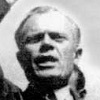
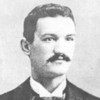
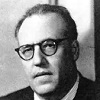
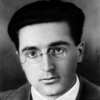
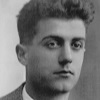
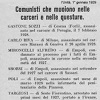
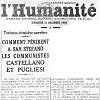
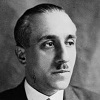
The socialist leader Sandro Pertini, who was president of the
Italian Republic from 1978 to 1985, was secluded in Santo Stefano
from 1929 to 1930, and many years later, in 1947, once elected
deputy of the Constituent Assembly, reminded in a speech before
the assembly that "Rocco Pugliese was dispatched in the
prison of Santo Stefano when I was there, in restraints".
The speech of Pertini was a reply to the answer given by the Minister
of Justice Giuseppe Grassi to a question he made about the thrashing
made by the jailers of some prisoners of Poggioreale jail in Naples,
followed by the death of one of them.
Pertini was very clear: "... I speak for personal experience
(...). In jail, Honourable Minister, it happens this: a prisoner
is struck; in consequence of the blows the prisoner dies, and
then everybody worries, and not only the jailers who stroke the
prisoner worry, but also the director, the doctor, the chaplain
and all the prison crew do it. And then they make this: they lay
the prisoner bare, they hang him to the window's grating and they
let him be found hanging this way. The doctor comes and he draws
up a medical report of suicide. This was the end of Bresci. Bresci
has been struck to death, then they hung the corpse to the window's
grating of his cell at Santo Stefano, where I have been a year
and half".
Pertini referred to the death of Gaetano
Bresci, the anarchist from Prato, near Florence, sentenced
to life imprisonment for the murder of the king Umberto I (see
my webpage about him), but died in
1901, after few months from his transfer to Santo Stefano.
Ugoberto Alfassio Grimaldi, quoting testimonies of political prisoners,
writes of Bresci: "That May 22nd
three guards made him the "Santantonio": that is covering
somebody with blankets and sheets and then beating him until his
death; his corpse had been buried, in a place of which remained
no trace in Santo Stefano archives, by two lifers who were sent
purposely there from an other jail, and then immediately away;
the penitentiary's commander had been promoted and the three jailers
had been rewarded".
The communist Girolamo Li Causi,
later senator of the Republic, wrote in his autobiography: "The
news that Pugliese himself had died caused me great pain. Our
companion, suffering from the mistreatment and abuse to which
he was subjected, had decided to go on hunger strike: in an attempt
to force him to gulp down the food, the custody only succeeded
in strangling him. He was a great fighter, full of vitality and
spirit of sacrifice; another comrade leaving ...".
Moreover Pertini, in a testimony reported in a book edited by
Vico Faggi, relates: "One night I was awaken by a choked
cry «mummy, mummy!». The day after somebody spread
the rumour that Rocco Pugliese hanged himself; but the suicide
was nothing more than an act. Pugliese had been killed by the
jailers."
In the same work is reminded that the murder of political prisoners
in the fascist jails wasn't un uncommon case, how testified by
the cases of Gastone Sozzi in
Perugia jail and Romolo Tranquilli,
the brother of the writer Ignazio Silone, in Procida jail. The
January 1st , 1929 clandestine edition of
l'Unità reported the
names of Communist prisoner dead or anyway sick in the fascist
jails.
Rocco's death was immediately perceived as a murder and the news
came to the anti-Fascist circles in Italy and in exile. The French
Communist Party's newspaper "L'Humanité"
published on December 21st, 1930 an article
by Gabriel Péri,
who was later a Communist member of parliament and a victim of
the Nazis, entitled: "Comment périrent à
San Stefano les communistes Castellano et Pugliesi" ("How
the Communist militants Castellano and Pugliesi died in Santo
Stefano") (Pugliese
L.), which denounced
the death of two Communist prisoners, Castellano and Rocco Pugliese,
(erroneously referred to as "Pugliesi"), and the serious
health condition of the communist militant Emmanuelli and of Sandro
Pertini, ill with tuberculosis. The article attributed the death
of Rocco to a reprisal by the guards for refusing their sexual
advances, shouting instead aloud to fight them off. Later Rocco
would have been harassed by providing him uneatable food, which
he refused, triggering segregation and fasting at the "enclosure
bed", with subsequent death.
Péri's article and the spread of the news by the exiled
antifascists embarassed the fascist regime, and Mussolini established
a farcical commission of inquiry into the conditions of inmates
in prisons, chaired by the Deputy Attorney General Claudio Rizzo,
who already on January 19th concluded his work by writing
: "at the beginning of last October (...), together with
a more notable state of organic decay, a real form of psychopathy
began to manifest itself in Mr. Pugliese, manifested in violent
excesses and in a characteristic delirium of persecution, which
led him to consider any food poisoned, and therefore to refuse
to ingest it (...). On October 12th,
he was hospitalized in the sick bay, diagnosed with strophobia,
persecution mania, apical phlegm, T.B. and cardiac neurosis, and,
by prescription from the doctor, he had to be secured to the enclosure
bed and subjected to artificial nutrition." On October 15th,
according to the report, the director of the penitentiary proposed
the transfer of Rocco to the criminalal asylum in Naples, which
could not happen because "the prisoner died of cardiac
paralysis in the afternoon of the 17th". (Bongiorno). The commission predictably gave
no results, except for a temporary alleviation of the brutish
prison treatment.
Rocco's family knew of his death almost by chance and the corpse
was never given back.
(Cordova,
1965) The police headquarters in Reggio
Calabria took measures to prevent Rocco's funeral from generating
demonstrations against the regime and gave instructions for the
funeral "not to take place in public form and for the
body to be transported overnight from the Palmi railway station
to the cemetery", but actually Rocco's body never arrived
in Palmi and it was probably destroyed in Santo Stefano (Bongiorno, Pugliese
L.) like probably
it happened to Gaetano Bresci's body.










A theatrical
work and six books
The theatrical company
Teatridelsud of Palmi staged a play called "L’Arrobbafumu"
a work by Francesco Suriano, interpreted by Peppino
Mazzotta, taken by a book by
the same author, taking a hint from the events of Palmi to tell
about the Calabria and its delays of development.
The Calabrian writer Domenico Gangemi
published in 2004 a novel freely inspired from the events of the
Varia of 1925 entitled "'25 nero",
published by Pellegrini Editore. Besides Natale Pace, a moderate
representative and deputy mayor of Palmi, in his essay "Il
debito" ("The Debt"), published in 2006 by Laruffa
Editore, tells Rocco's vicissitude from the point of view of Leonida
Repaci, who was a close friend with the author.
In 2008 Giuseppe (Pino) Bongiorno,
son of Antonino, published the book "Una
vita da comunista" ("A life as a Communist")
for the publisher L'Albatros of Rome, dedicated to the life of
his father, which gives wide room to the events of the Varia of
1925 and to the legal proceedings of his father, of Rocco and
of all the other defendants.
In 2015 the publisher Annales of Rome edited "Rocco
Pugliese: un Comunista di Calabria" a nice book by
Lorenzo Pugliese, a relative
of Rocco, which reports with passion and involvement the outcome
of a 18 years research, performed by the author through archives,
journals, libraries and witnesses' stories. This book entirely
fulfils Sandro Pertini's wish, expressed to a Rocco's niece, so
that the sacrifice of this young man from Palmi was never forgotten.
In 2017, the journalist Pier Vittorio
Buffa issued the book "Non volevo
morire così" ("I didn't want to die
like this"), published by Nutrimenti of Rome, which tells
the stories of Santo Stefano prisoners and Ventotene confinees,
collected largely from their dossiers kept in the archives, including
those of Santo Stefano. A chapter is dedicated to Rocco Pugliese.
The city of Palmi named a street
after Rocco Pugliese and on April 25th, 2018 placed a plaque
in viale Rimembranze, 20, in the place where his house once stood:
For everlasting memory, here
stood the native home of
Rocco Pugliese 1903-1930.
A Palmese Communist who with other young antifascists established
the cell of the Communist Party of Italy in Palmi.
Innocent and Condemned by the Special Court for the "facts
of the Varia" of 30th August, 1925 killed by the Fascist brutality
in Santo Stefano Penitentiary.
"One night I was awaken by a choked cry «mummy,
mummy!». The day after somebody spread the rumour that Rocco
Pugliese hanged himself; but the suicide was nothing more than
an act. Pugliese had been killed by the jailers."
Sandro Pertini.
THE CITY PLACED
Palmi April 25th, 2018.
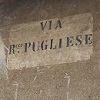
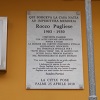
Rocco
Pugliese nowadays
In spite of his seclusion,
murder and concealment of his corpse, though more than ninety
years went by from his death and maybe noone of those who knew
Rocco is still alive, that 27 years old young man from Calabria
is still living in memory, his sacrifice still arouses gratitude
and his brutal murder still inspires horror and indignation.
BIBLIOGRAPHIC
REFERENCES:
-
ALFASSIO GRIMALDI Ugoberto (1970) Il re "buono". Feltrinelli,
Milano. Pag. 468-470.
- AJELLO Nello (2003) Il confino. Ecco le vacanze che offriva
il duce. La Repubblica, 13 settembre 2003, pag. 39.
- AMENDOLA Eva Paola (2006) Storia fotografica del Partito Comunista
Italiano. Editori Riuniti, Roma.
- BONGIORNO Pino (2008) Una vita da comunista. Biografia di Antonino
Bongiorno. L'Albatros, Roma.
- BUFFA Pier Vittorio (2017) No volevo morire così. Nutrimenti,
Roma. Pag. 87-94.
- CORDOVA Ferdinando (1965) Il processo Gerocarni. Historica,
16 (18): 196-212.
- CORDOVA Ferdinando (1977) Alle origini del PCI in Calabria -
1918-1926. Bulzoni, Roma.
- CORDOVA Ferdinando (1994) Un originale documento sui fatti di
Palmi dell'estate del 1925, Historica, XLVII-4, pag. 157-167.
- DA PASSANO Mario Il «delitto di Regina Cœli»
(link)
- DAL PONT Adriano (1975) I lager di Mussolini. La Pietra,
Milano.
- DAL PONT Adriano, LEONETTI Alfonso, MAIELLO Pasquale, ZOCCHI
Lino (1962) Aula 4: tutti i processi del Tribunale speciale fascista.
ANPPIA, Roma.
- FAGGI Vico (edited by) (1970) Sandro Pertini: sei condanne due
evasioni. Mondadori, Milano.
- GALZERANO Giuseppe (1988) Gaetano Bresci: la vita, l' attentato,
il processo e la morte del regicida anarchico. Galzerano editore
- Atti e memorie del popolo - Casalvelino Scalo (Salerno).
tel. and fax: +39.0974.62028 http://galzeranoeditore.blogspot.it/ e-mail: giuseppe.galzerano@tiscalinet.it
- GANGEMI Domenico (2004) '25 nero. Luigi Pellegrini Editore,
Cosenza.
- GHINI Celso, DAL PONT Adriano (1971) Antifascisti al confino
1926-1943. Editori Riuniti, Roma.
- LI CAUSI Girolamo (1974) Il lungo cammino : autobiografia 1906-1944.
Editori Riuniti, Roma. p. 151-152
- LISA Athos (1973) Memorie. In carcere con Gramsci. Feltrinelli,
Milano.
- MARIANI Giuseppe (1954) Nel mondo degli ergastoli, S.n.,
Torino..
- PACE Natale (2006) Il debito. Leonida Repaci nella storia. Laruffa
Editore, Reggio Calabria.
- PERTINI Sandro (1947) in "Atti dell’Assemblea Costituente.
Discussioni", IX, 19 novembre 1947, 2179-2180.
- PUGLIESE Amelia (s.a.) Viaggio nella casa di correzione penale
di Santo Stefano. http://www.ventotenet.org/tourinfo/santostefano.htm.
- PUGLIESE Lorenzo (2015) Rocco Pugliese: un Comunista di Calabria).
Annales, Roma. link
- SPEZZANO Francesco (1968) La lotta politica in Calabria: (1861-1925).
Lacaita, Manduria.
- SPEZZANO Francesco (1975) Fascismo e antifascismo in Calabria.
Lacaita, Manduria.
- SPEZZANO Francesco (1984) Item "Pugliese, Rocco" in
"Enciclopedia dell’antifascismo e della Resistenza".
La Pietra-Walk Over, Milano. IV: p. 813-814.
- SPRIANO Paolo (1969) Storia del Partito Comunista Italiano.
Einaudi, Torino.
WEB
REFERENCES (accessible
on: October 29th,2022):
http://www.ecn.org/filiarmonici/santostefano.html
https://en.wikipedia.org/wiki/Palmi
https://en.wikipedia.org/wiki/Leonida_Repaci
http://www.terreprotette.it/tp2/106
http://www.ventotene.it/escursioni.aspx
https://circoloarmino.files.wordpress.com/2014/04/antifascisti-nati-o-residenti-a-palmi.pdf
no longer
accessible on: October 29th,2022:
http://www.anpi.it/ts/1928_4trim.htm
http://www.variadipalmi.it/curiosita.asp?modulo=leggi&ID=6
http://spazioinwind.libero.it/nb/vittoriofoa/tribunale.htm
http://www.teatrodellacquario.com/stagioni/2007/schede/arrobbafumo.htm
http://www.variadipalmi.it/
http://www.marcellobotarelli.it/santostefano/index.htm
http://www.istoreco-re.it/isto/default.asp?id=326&lang=ITA
http://www.domenicogangemi.it/
http://www.traveleurope.it/ventoten.htm
 Page
created on: March
1st, 2009 and last updated: November 22nd, 2022
Page
created on: March
1st, 2009 and last updated: November 22nd, 2022